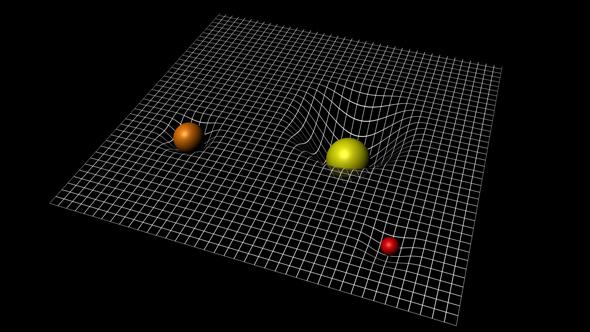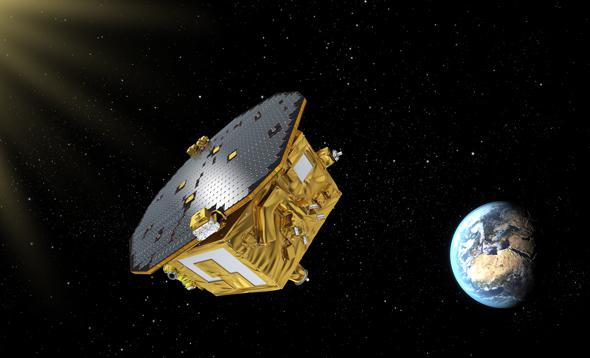Update 3, Dec. 3, 2015 at 17:15 UTC: Success! The Vega rocket lifted off right on time, and LISA Pathfinder is in orbit. Over the next two weeks it will undergo a series of orbit-raising engine burns, the last of which will send it to its destination at the L1 point.
Update, Dec. 2 at 19:00 UTC: The launch has been rescheduled for tonight at 04:04 UTC (11:04 p.m. Eastern US time). To be clear, that’s Wednesday night for the US, and Thursday morning for Europe. Other than that, the details in the article below still stand, including the link to watch live.
Update, Dec. 1 at 17:00 UTC: ARG! Literally within a few minutes of this post going live, I got an email saying the launch has been delayed due to an unspecified technical issue on the rocket. As soon as a new launch date and time are announced I’ll update this post.
If all goes well, Tuesday night at 04:14 UTC (11:14 p.m. Eastern U.S. time) the European Space Agency will launch a weird little kind-of-astronomical observatory into space. Called LISA Pathfinder (for Laser Interferometer Space Antenna), it’s a technology testbed, designed to see if some very advanced technology is capable of detecting gravitational waves—and if it does, to pave the way to perform these measurements in future missions on a much larger scale.
OK, first off, the launch will be on a Vega rocket blasting off from Kourou, French Guiana. It’ll be streamed live on ESA’s livestream channel. Once in orbit, LISA P will slowly move itself about 1.5 million kilometers from the Earth toward the Sun, to what’s called the first Lagrange point, where the gravitational effects of the Earth and Sun balance.

Drawing by ESA–C.Carreau
Once there, the experiment begins. Inside LISA P are two free-floating cubes. Hardware inside the satellite will measure the positions of these cubes to an accuracy of—get this—a picometer, or one trillionth of a meter. Yes, seriously. The need for such accuracy is critical, because what LISA P is testing is the ability to detect ripples in the very fabric of space and time.
Again, yes, seriously. Albert Einstein was a pretty smart guy, and came up with the theory of relativity, which, among many other amazing things, postulated that gravity isn’t really a force between two objects, but instead a bending of space (and time) itself. Space isn’t just emptiness, the idea goes, but actually a thing with shape and geometry, a cosmic matrix in which we are all embedded.
If you have an object with mass (like a star) sitting in space, then space bends around it, and a passing object (like a planet) has its path curved. We call that curvature gravity.
But it gets better. If you have two objects revolving around each other, then they give off gravitational waves, which are similar to ripples in water. These waves are usually extremely low energy and long wavelength, making them very difficult to detect. But if you have two very dense objects spinning around each other rapidly, the waves are sharper and easier to measure.
Two black holes fit that bill. So do lots of other objects (neutron star or white dwarf binaries, for example). As these ripples in spacetime move outward, they ever so slightly expand and contract the fabric of space. Now imagine you have two cubes floating in space. As the ripples pass by them (moving at the speed of light), then the distances between the cubes will change ever so slightly.
That’s the technology LISA P is testing. By measuring the distances between the cubes to phenomenal accuracy, it’s hoped that these ripples will be seen. We’ve been looking for them for a long, long time, but like I said, they are very difficult to detect. One instrument on Earth, called LIGO, has been looking for years, and is just now reaching the sensitivity needed to detect these waves.
By putting a spacecraft far from Earth, though, better sensitivity can be achieved. About 10 years or so ago, NASA and ESA were looking into building a full-up LISA, which would be three spacecraft flying in formation, separated by 5 million kilometers, but able to measure their relative position to better than a nanometer (a billionth of a meter), and each with two of those free-floating cubes in them. It was deemed too expensive and difficult, and with a tight budget, NASA had to bail on it.
Happily, ESA didn’t cancel it outright. They scaled it back to the LISA P mission to first test the tech out. Back in the early 2000s I was part of a NASA Education and Public Outreach team involved with several astronomical observatories, and LISA was one of those missions. I was fascinated by the extremely advanced technology for it, and excited by the science it would do. Obviously, I wasn’t thrilled when NASA was forced out due to budget cuts and the ballooning costs of other missions, but it’s pretty gratifying to see this Pathfinder mission finally get into space.
I’ll be watching the launch livestream Tuesday night. Congrats to the ESA team for getting to this point, and let’s hope everything goes well for LISA P!
